
Creating a garden from (literally) the ground up is one of the most rewarding activities there is. Not only is it good for your mental and physical health, it's one of the few hobbies that helps you redefine and improve the space you live in. It also provides the opportunity for a lifetime of education: You can pick up the basics over a single growing season, but a garden can still teach you something new every year. Here's our concise guide to getting started.
Supplies You Need
Video of the Day
There are a lot of tools and other supplies that you'll need as you start your garden, and this list will help you set yourself up with the basics. It's by no means comprehensive, but it covers the items that most gardeners will need or want.
Video of the Day
Work gloves to protect your hands
Knee pads to minimize joint pain, or better yet...
A foldable kneeler/garden seat which can be used sitting or kneeling
Durable, reusable black plastic for weed suppression
Sturdy lawn edging to outline flower beds
A durable rake for leveling your beds
A selection of pruning shears
Soaker hoses for efficient watering
Compost to enrich your soil
Burlap to protect plants in winter
How to Start a Garden
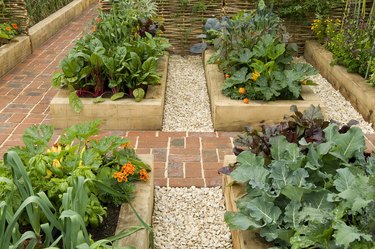
1) Set Realistic Goals
Novices may over-commit when planning a first garden. You can avoid that common trap by starting small and building as you go. If you've never gardened before, producing enough vegetables to feed your family is a monumental task. On the other hand, "a splash of color out front to make the house prettier" or "a few herbs on that sunny corner of the patio," is manageable for most people at any age or fitness level.
If you're interested in flowers, start with a couple of modestly-sized beds in places where they'll have a lot of impact. If you want to grow food, start with a manageable plot – maybe two or three beds measuring 4 feet by 8 feet – and prioritize the things you most want to grow. Easing into your new hobby will keep it fun, rather than stressful.

2) Choose Your Spot
The next step is to choose the place where you'll create your garden. Ideally this would be a place where the soil is rich, the drainage is good and there's lots of sunshine, but that's not always possible. For ornamental beds, usually you'll pick spots for visual impact, and work backward from there to choose the right flowers, shrubs and edging plants to suit the growing conditions in those spots.
For a vegetable garden you absolutely need sunshine, but you can work around everything else. All-day sun is best, but you can make do with some shade in the mornings or late afternoons (and in hot climates, afternoon shade is a bonus). One final point, with vegetable gardening: Beware of potential contaminants. Don't plant over a septic field, don't plant where the old garage used to be, and avoid that spot along the fence behind your neighbor's much-sprayed roses. When in doubt, get your soil tested.
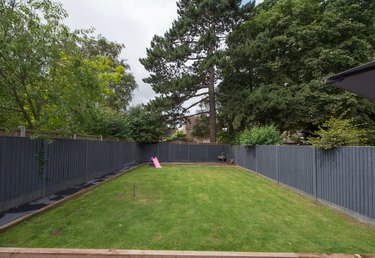
3) Plan Your Garden
Next, take a moment and plan how your garden will look. For flower beds and ornamentals, you'll want to give some thought to the shape of your bed – an oblong or kidney shape in open space, a ring around a tree, a boomerang to fill in a corner spot – as well as its size.
For a vegetable garden, orient the beds north-south whenever possible to maximize the available sunshine. The most versatile arrangement for a small garden is beds 3 to 4 feet wide with 12- to 20-inch walkways between them. The walkways give you a place to stand, and you'll be able to easily reach the middle of your beds from either side.
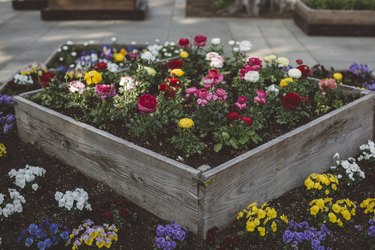
4) Create Your Beds
The most traditional way to create your beds is by digging, but that's a lot of work and promotes weed growth. One pragmatic alternative is to smother the existing grass and weeds with black plastic for a few weeks before planting. Once the plastic has done its work, you pick it up and build your beds with fresh soil.
Alternatively you can smother the existing turf with corrugated cardboard, which can be left in place under your beds (your plants will grow through the cardboard as it decomposes). Some gardeners will choose to dig their beds rather than bringing in topsoil, and that's fine too. If you turn them over ahead of time, you can still use either the plastic or cardboard technique to prevent weeds from springing up alongside your veggies.
Finally, there's the question of whether to enclose your beds. With ornamentals or flower beds, some gardeners like to outline them with lawn edging for a neat appearance. If you do this, choose edging that will stand up to occasional visits from your string trimmer. For vegetable beds, framing them with wood is a more common choice. You can frame a 4- by 8-foot bed with three pieces of 8-foot lumber; just saw one in half for the end pieces, nail them together to make a rectangle around the soil, then rake to level the surface from edge to edge.

5) Choosing What to Plant
Now that your garden is planned and laid out, you'll need something to plant in it. It's a complex decision – part of the reason gardening is a lifelong learning experience – with a lot to take into account. You'll need to consider your overall local climate, the amount of sun your chosen plot receives, the time between spring's last frost and autumn's first frost, and many other factors.
For flowers and ornamentals, choose plants that can flourish in the amount of light you can give them. There's something for every situation, from full light to deep shade. Next, sort out the visuals: A mix of heights, colors and textures is always good, sometimes with a couple of large and striking plants to anchor the bed visually. On the grounds of practicality, planting lots of low-maintenance perennials and then filling in the gaps with annuals works well.
For vegetables and herbs start with things you actually like to eat, and then narrow your selection to varieties that grow well in your climate. Some crops – peas, lettuces, spinach – prefer the cool, so they're best planted early in spring (and again in late summer, for an autumn harvest). Slow-maturing plants like melons, winter squash and peppers are best grown from transplants if you live in a colder climate, because that gives them a head start.

6) Care and Feeding
Plants typically require an inch or two of water per week, and if you don't get it from rain you'll need to irrigate. The most effective way to do that is with soaker hoses, or in-ground irrigation Water in the evening, to minimize evaporation, and avoid getting the plants' foliage wet (wet leaves encourage disease). In dry or water-restricted climates, choose plants for drought-tolerance.
Weed often while your seedlings and transplants are still young and delicate. If you've smothered your weeds beforehand with plastic or cardboard, it shouldn't take more than a few hours each week for a modest-sized garden. Once your plants are 8 to 10 inches high, they'll hold their own against most weeds, and you won't need to be quite as diligent. Layering mulch between the plants will help suppress weeds, and also help retain moisture.
Some vegetables benefit from side-dressing with organic or chemical fertilizers during the growing season, while others – notably peas and beans – actually enrich the soil as they grow. There's no simple rule to follow, so research the plants you're growing and provide a nutritional boost as and if needed.
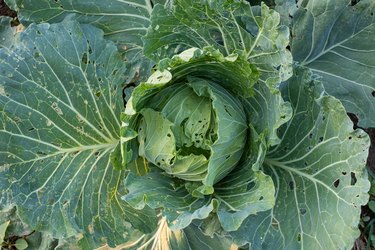
7) Pests and Diseases
Eventually every gardener loses plants to pests or disease. If your plants begin to look chewed-on or unhealthy, a quick internet search or phone call to your local extension service can probably tell you what's causing the problem and what to do about it.
Diseases can often be dealt with by removing the affected plants immediately and burning them or putting them out in the trash. Fungicides can salvage plants that have been attached by molds, and many DIY home remedies are effective. Insect pests can be hand-picked from your plants and drowned in a container of soapy water, or you can buy natural predators to release in your garden as a preventative measure. Pesticides should be a last resort, because they threaten pets and pollinators as well as the pests you're targeting.
Providing good airflow between plants, and removing debris regularly, can help prevent a lot of problems. It's also important to rotate your crops from year to year in a vegetable garden, so pests can't find their preferred food in the same place over and over again.
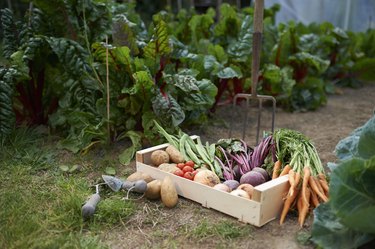
8) Bringing in Your Harvest
For vegetable gardeners harvest time is your payoff; it's what all the work has been for. You can start harvesting radishes, baby greens and the first few snow peas just a few weeks into the season, and it won't stop until the frost kills your plants in the autumn. It can be overwhelming if you've planted too much, and zucchini in particular are notoriously over-productive.
It's best to harvest frequently – usually every day – to keep your plants productive. The more tomatoes, beans and zucchini you pick, the more the plants will bear. In the case of lettuces, chard, kale and other greens, you can harvest the outer leaves constantly throughout the growing season instead of cutting down the entire head all at once.
You can avoid being overwhelmed by planting early-, mid- and late-season varieties of some vegetables, or by planting at 2- or 3-week intervals. That keeps the harvest manageable, and gives you more variety.
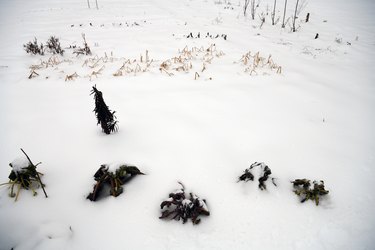
9) Preparing for Next Year
The final step in this year's garden is preparing it for next year. Once your harvest is complete, and frost has killed your plants, remove the dead plant material (it's potentially a habitat for pests to over-winter). In flower beds, cover ornamental shrubs with burlap to protect them from harsh winter weather, remove dead annuals, and dig up any bulbs that need to be overwintered indoors.
This is the ideal time to replenish your soil by adding manure, mature compost or a layer of mulch that can decompose over the winter and be ready for springtime planting.
Finally, this is the time to review and reflect on your year's successes. Record what varieties you chose, when they were planted, where they were planted, and how well they grew. Next year you can refer back to those notes, bringing back the successful plants and swapping out the failures for other varieties. Over time, you'll learn which plants function best for your microclimate and your gardening style.
Easy Projects for Beginners
Your garden is a large, seasons-long enterprise, but you'll find that there are a number of smaller projects you can tackle along the way. Here are a few we've selected to help you gain skills and confidence.
- Texas A&M AgriLife Extension: Gardening can Influence and Benefit Your Mental Health
- Maryland Grows: Want to Start a Vegetable Garden? Here's How
- University of Florida IFAS Extension: Considerations for the New Gardener
- UC Master Gardeners of Butte County: Work Less and Grow More Vegetables with "No Till" Gardening
- Michigan State University: Integrated Pest Management in Vegetable Gardens
- University of Minnesota Extension: Prepare Your Vegetable Garden for Winter